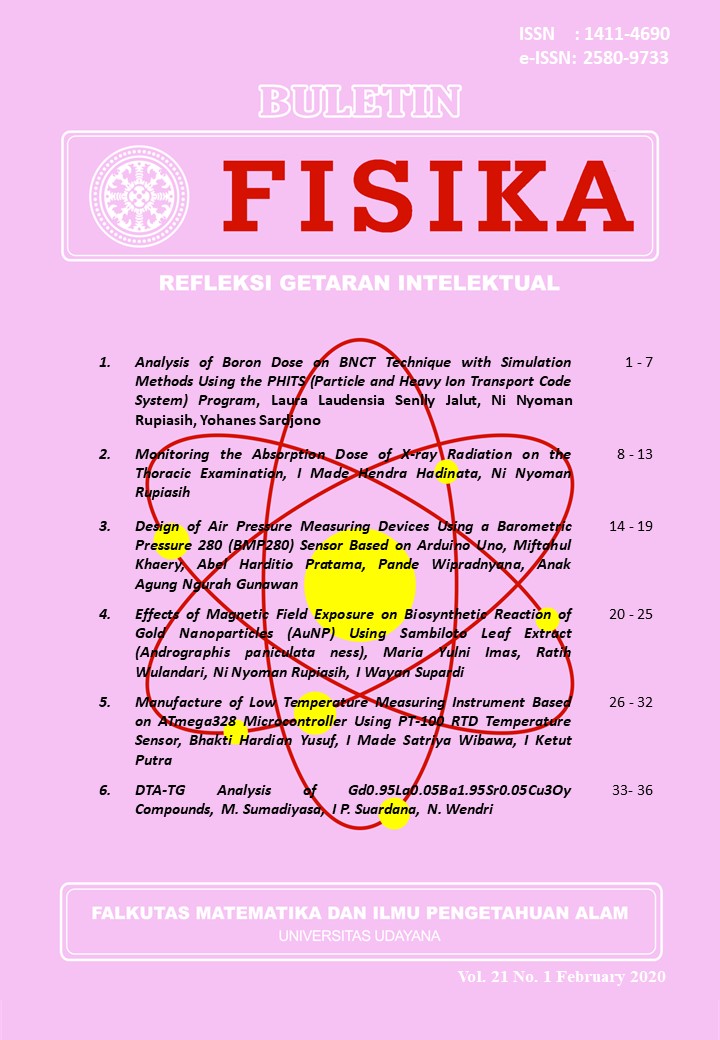Monitoring the Absorption Dose of X-ray Radiation on the Thoracic Examination
Hasil revisi
Abstract
The study of monitoring the absorption dose of X-ray radiation received by thoracic examination patients has been conducted. The absorbance dose received by the patient is calculated from the exposure factor data consisting of electric voltage (kV), current (mA), time (s), and examination distance (m). Data were obtained from 130 male patients and 60 female patients, who performed thoracic examinations in a Posterior Anterior (PA) position. The absorbed dose received by male and female patients is compared with the maximum absorbed dose determined by BAPETEN for thoracic examinations on adult patients, which is 0.4 mGy. Differences in the absorbed dose received by male and female patients were identified by the T-test of two free samples with a significance level of 0.05. The results showed that the dose of X-ray radiation received by male and female patients was still below the maximum absorbed dose determined by BAPETEN, and the results of the T-test showed no significant difference in the absorbed dose received by male and female patients.
Downloads
References
[2] E. Hiswara, Buku Pintar Proteksi dan Keselamatan Radiasi di Rumah Sakit, BATAN Press, 2015.
[3] A. Musfira, Analisis Perbandingan Dosis Serap Radiasi Foto Thorax Pada Pasien dengan Berbagai Tingkatan Umur, Skripsi, UIN Alauddin Makasar, 2016.
[4] T. Dianasari, dan H. Koesyanto, Penerapan Manajemen Keselamatan Radiasi di Instalasi Radiologi Rumah Sakit, Unnes Journal of Public, vol 6, no .3, 2017, pp. 174-183.
[5] E. Widayati. Analisis Dosis Serap Radiasi Foto Thorax Pada Pasien Anak di Instalasi Radiologi Rumah Sakit Paru Jember, Skripsi, Universitas Jember, 2013.
[6] H. M. P. Purba, Analaisis Dosis Serap, Citra, dan Faktor Ekspose Pada Rontgen Toraks Berdasarkan Usia dan Berat Badan dengan Menggunakan X-Ray Konvensional, Skripsi, Universitas Sumatera Utara, 2018.
[7] S. Daryati, R. Indrati, dan N. W. Illahi, Gambaran Dosis Serap Pada Pemeriksaan Radiografi Toraks Anak di Instalasi Radiologi Rumah Sakit Paru dr. Ario Wirawan Salatiga, Jurnal Imejing Diagnostik, vol 5, no. 1, 2019, pp 31-33.
[8] A. W. Sari dan S. Hartina, Uji Kesesuaian Collimator Beam dengan Berkas Sinar-X Pada Pesawat Raico di Instalasi Radiologi Raden Mattaher Jambi, 2017. Tersedia dari: http://scholar.google.com, diakses 6 Januari 2019.
[9] A. Fahmi, K. S. Firdausi, dan W. S. Budi, Pengaruh Faktor eksposi Pada Pemeriksaan Abdomen Terhadap Kualitas Radioraf dan Paparan Radiasi Menggunakan Computed Radiography, Berkala Fisika, vol 11, no .4, 2008, pp 109-118.
[10] M. Akhadi, Dasar-Dasar Proteksi Radiasi, Rineka Cipta, 2000.
[11] Meredith, W. J. and Massey, J. B, Fundamental Physics of Radiology 3rd Edition, A John Wright & Sons Ltd. Publication, 1977.
[12] Kementrian Riset, Teknologi dan Pendidikan Tinggi, Penuntun Ketrampilan Klinis Pemeriksaan Radiografi Toraks, Universitas Andalas, 2016.
[13] S. Akunsari, Hubungan Antara Paparan Debu Kapas dengan Kejadian Penurunan Kapasitas Fungsi Paru Tenaga Kerja Wanita di PT. Dan Liris Sukoharjo, Skripsi, Universitas Sebelas Maret, 2010.
[14] W. Fitrianti, Hubungan Antara Ekspansi Thoraks dan Indeks Massa Tubuh dengan VO2Max Pada Lanjut Usia (Lansia), Skripsi, Universitas Muhammadiyah Surakarta, 2013.
[15] S. Sandstrom, The WHO Manual of Diagnostic Imaging: Radiographic Technique Projections, EGC, 2011.











